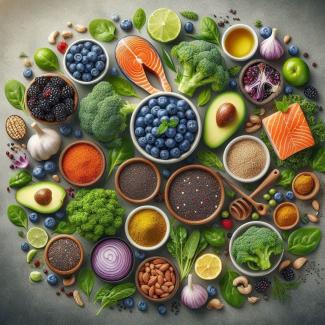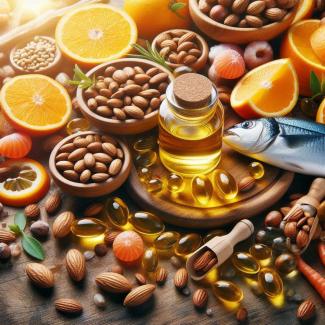
Superfoods are nutritionally dense foods that are believed to be especially beneficial for health and well-being. While the term "superfood" is often used in marketing, many of these foods have been shown to possess exceptional nutrient profiles and health benefits through scientific research. This detailed guide explores some of the best superfoods, their nutritional content, and how they contribute to overall health.
1. Blueberries
Nutritional Profile:
Blueberries are small, sweet, and packed with nutrients. They are rich in fiber, vitamins C and K, and manganese. Blueberries are also a significant source of antioxidants, particularly anthocyanins, which give them their vibrant blue color.
Health Benefits:
- Antioxidant Powerhouse: Blueberries are one of the highest antioxidant-containing fruits. Antioxidants help neutralize free radicals in the body, reducing oxidative stress and inflammation.
- Brain Health: Several studies have shown that blueberries may support brain function and delay age-related cognitive decline. The antioxidants in blueberries, particularly flavonoids, have been linked to improved memory and cognitive function.
- Heart Health: Blueberries have been shown to lower blood pressure and cholesterol levels. They also improve arterial function and reduce the risk of heart disease.
- Blood Sugar Regulation: Despite their sweetness, blueberries have a low glycemic index, meaning they have a minimal effect on blood sugar levels. Studies suggest that they can improve insulin sensitivity and may be beneficial for managing type 2 diabetes.
How to Include in Your Diet:
Blueberries can be consumed fresh, frozen, or dried. They make an excellent addition to smoothies, salads, oatmeal, and yogurt. You can also enjoy them on their own as a healthy snack.
2. Kale
Nutritional Profile:
Kale is a leafy green vegetable that is extremely nutrient-dense. It is an excellent source of vitamins A, C, and K, along with calcium, potassium, and magnesium. It also contains fiber, antioxidants, and various bioactive compounds.
Health Benefits:
- Detoxification Support: Kale contains glucosinolates, which are compounds that support the body’s natural detoxification processes. These compounds are broken down into isothiocyanates, which promote liver function and help eliminate toxins from the body.
- Heart Health: Kale is high in potassium and low in sodium, which supports healthy blood pressure levels. It also contains lutein and zeaxanthin, antioxidants that protect against the oxidation of LDL cholesterol, a key factor in heart disease.
- Bone Health: The high vitamin K content in kale is crucial for maintaining healthy bones, as vitamin K is required for the production of osteocalcin, a protein essential for bone mineralization.
- Cancer Prevention: The antioxidants and anti-inflammatory compounds in kale may help reduce the risk of cancer. Some studies suggest that the isothiocyanates formed from glucosinolates can inhibit cancer cell growth.
How to Include in Your Diet:
Kale can be eaten raw, cooked, or added to smoothies. It works well in salads, soups, and stir-fries. Kale chips, made by baking kale leaves with a drizzle of olive oil and seasoning, are a healthy snack option.
3. Quinoa
Nutritional Profile:
Quinoa is a gluten-free whole grain that is packed with protein, fiber, and essential vitamins and minerals such as magnesium, phosphorus, and iron. It is one of the few plant-based foods that provides all nine essential amino acids, making it a complete protein source.
Health Benefits:
- High Protein Content: Quinoa is a fantastic protein source, particularly for vegetarians and vegans. The high protein content helps in muscle building and repair, as well as supporting immune function and overall growth.
- Blood Sugar Regulation: Quinoa has a low glycemic index, meaning it causes a slower rise in blood sugar levels compared to refined grains. This makes it an excellent choice for people with diabetes or those trying to manage their blood sugar levels.
- Digestive Health: The high fiber content in quinoa aids in digestion, prevents constipation, and promotes a healthy gut microbiome.
- Heart Health: Quinoa is rich in magnesium, a mineral that helps relax blood vessels and supports cardiovascular health. Its fiber content also helps reduce cholesterol levels, further supporting heart health.
How to Include in Your Diet:
Quinoa can be used as a base for salads, added to soups, or served as a side dish. It can also be used in place of rice or pasta in many dishes. Quinoa flakes can be used in baking or as a breakfast cereal.
4. Salmon
Nutritional Profile:
Salmon is an excellent source of high-quality protein and omega-3 fatty acids, particularly EPA and DHA. It is also rich in B vitamins, vitamin D, selenium, and potassium.
Health Benefits:
- Heart Health: The omega-3 fatty acids in salmon have been shown to reduce inflammation, lower blood pressure, decrease triglycerides, and reduce the risk of heart disease. Omega-3s also support healthy cholesterol levels by raising HDL (good cholesterol) and lowering LDL (bad cholesterol).
- Brain Function: DHA, one of the omega-3 fatty acids found in salmon, is essential for brain health. Regular consumption of omega-3s has been linked to improved cognitive function and a reduced risk of neurodegenerative diseases such as Alzheimer's.
- Joint Health: Omega-3s have anti-inflammatory properties that can help reduce symptoms of rheumatoid arthritis and other inflammatory joint conditions.
- Skin Health: Omega-3s in salmon also benefit the skin by reducing inflammation and supporting hydration, elasticity, and overall skin health.
How to Include in Your Diet:
Salmon can be grilled, baked, or pan-seared. It pairs well with a variety of vegetables and whole grains. Smoked salmon is a popular option for adding to salads, sandwiches, or breakfast dishes like scrambled eggs or avocado toast.
5. Avocados
Nutritional Profile:
Avocados are a unique fruit, rich in healthy monounsaturated fats, fiber, and several vitamins and minerals, including potassium, vitamin K, vitamin E, and folate. They are also loaded with antioxidants, such as lutein and zeaxanthin.
Health Benefits:
- Heart Health: The monounsaturated fats in avocados help reduce LDL (bad) cholesterol levels while raising HDL (good) cholesterol. This balance supports overall heart health and reduces the risk of heart disease.
- Weight Management: Despite being calorie-dense, avocados can aid in weight management due to their high fiber content and ability to promote satiety, helping control appetite.
- Eye Health: Avocados contain lutein and zeaxanthin, antioxidants that are beneficial for eye health. These compounds are particularly important in reducing the risk of cataracts and macular degeneration.
- Absorption of Nutrients: The healthy fats in avocados can increase the absorption of fat-soluble vitamins (A, D, E, K) and antioxidants from other foods.
How to Include in Your Diet:
Avocados can be added to salads, sandwiches, smoothies, or simply enjoyed on toast. They also serve as a base for guacamole and can be used as a substitute for butter or oil in baking.
6. Chia Seeds
Nutritional Profile:
Chia seeds are tiny but nutritionally powerful. They are rich in omega-3 fatty acids, fiber, protein, and minerals such as calcium, phosphorus, and magnesium. Chia seeds are also a good source of antioxidants.
Health Benefits:
- Digestive Health: Chia seeds are high in fiber, which helps promote regular bowel movements and supports a healthy digestive system. The soluble fiber in chia seeds can also help reduce cholesterol levels.
- Heart Health: The omega-3 fatty acids in chia seeds support heart health by reducing inflammation, lowering blood pressure, and improving cholesterol levels.
- Bone Health: Chia seeds are a great plant-based source of calcium, phosphorus, and magnesium, all of which are essential for maintaining strong bones.
- Blood Sugar Control: Chia seeds have been shown to help regulate blood sugar levels by slowing down the conversion of carbohydrates into sugar, making them beneficial for people with type 2 diabetes.
How to Include in Your Diet:
Chia seeds can be sprinkled on yogurt, oatmeal, or salads. They can also be soaked in water or milk to create a chia pudding or added to smoothies for an extra nutrient boost.
7. Spinach
Nutritional Profile:
Spinach is a dark leafy green vegetable that is packed with nutrients. It is rich in vitamins A, C, and K, as well as folate, iron, calcium, and magnesium. Spinach also contains various antioxidants such as beta-carotene and lutein.
Health Benefits:
- Eye Health: Spinach is rich in lutein and zeaxanthin, two antioxidants that are crucial for maintaining eye health. These compounds help protect the eyes from damage caused by ultraviolet light and reduce the risk of macular degeneration and cataracts.
- Bone Health: The high vitamin K content in spinach supports bone health by promoting calcium absorption and reducing calcium loss in the urine.
- Cancer Prevention: Spinach contains several phytonutrients, including flavonoids and carotenoids, that have anti-inflammatory and anticancer properties. These compounds may help reduce the risk of various cancers, including breast, prostate, and stomach cancers.
- Heart Health: Spinach is a good source of dietary nitrates, which have been shown to help reduce blood pressure, improve blood flow, and support cardiovascular health.
How to Include in Your Diet:
Spinach can be eaten raw in salads, sautéed as a side dish, or added to soups, stews, and casseroles. It also works well in smoothies and omelets.
8. Turmeric
Nutritional Profile:
Turmeric is a bright yellow spice commonly used in Indian cuisine. It contains curcumin, a powerful anti-inflammatory and antioxidant compound that is responsible for most of turmeric’s health benefits.
Health Benefits:
- Anti-Inflammatory Properties: Curcumin is one of the most potent natural anti-inflammatory compounds. It has been shown to reduce inflammation in the body, which can help alleviate symptoms of chronic diseases such as arthritis and inflammatory bowel disease.
- Antioxidant Effects: Curcumin neutralizes free radicals and boosts the body’s own antioxidant defenses. This can help protect cells from oxidative stress and reduce the risk of chronic diseases like cancer and heart disease.
- Brain Health: Curcumin may increase levels of brain-derived neurotrophic factor (BDNF), a growth hormone that supports the health of neurons and enhances brain function. This may help reduce the risk of neurodegenerative diseases like Alzheimer’s.
- Heart Health: Curcumin improves the function of the endothelium, the lining of blood vessels, which can help regulate blood pressure and reduce the risk of heart disease.
How to Include in Your Diet:
Turmeric can be added to curries, soups, and stews. It can also be used in smoothies, teas, or as a seasoning for roasted vegetables. Combining turmeric with black pepper enhances the absorption of curcumin.
9. Garlic
Nutritional Profile:
Garlic is a flavorful bulb that is rich in vitamins C and B6, manganese, selenium, and fiber. It also contains sulfur compounds such as allicin, which are responsible for its potent health benefits.
Health Benefits:
- Immune Support: Garlic has been shown to boost the immune system by stimulating the activity of immune cells and increasing the production of antibodies. It can help reduce the severity and duration of colds and other respiratory infections.
- Heart Health: Garlic can lower blood pressure, reduce cholesterol levels, and improve circulation. Its sulfur compounds have been shown to help relax blood vessels and prevent blood clots, reducing the risk of heart disease.
- Cancer Prevention: Some studies suggest that garlic may help reduce the risk of certain types of cancer, particularly stomach and colon cancer. Its sulfur compounds are believed to have anti-cancer properties.
- Antioxidant Properties: Garlic’s antioxidants help protect cells from damage caused by free radicals and may reduce the risk of chronic diseases like cancer and heart disease.
How to Include in Your Diet:
Garlic can be used to flavor a wide range of savory dishes. It can be eaten raw, roasted, sautéed, or added to sauces, soups, and marinades.
10. Green Tea
Nutritional Profile:
Green tea is made from the leaves of the Camellia sinensis plant. It is rich in antioxidants, particularly catechins, and contains small amounts of vitamins and minerals such as vitamin C, manganese, and potassium.
Health Benefits:
- Antioxidant Power: Green tea is loaded with antioxidants, especially epigallocatechin gallate (EGCG), which has been shown to protect cells from damage and reduce the risk of chronic diseases such as cancer and heart disease.
- Weight Loss: Green tea has been shown to boost metabolism and increase fat burning, making it a popular choice for those looking to lose weight.
- Brain Health: The caffeine and catechins in green tea work together to improve brain function, enhance memory, and protect against neurodegenerative diseases like Alzheimer’s and Parkinson’s.
- Heart Health: Green tea has been shown to reduce LDL (bad) cholesterol levels and improve blood vessel function, which can help reduce the risk of heart disease.
How to Include in Your Diet:
Green tea can be enjoyed hot or iced. It can also be used as a base for smoothies or added to soups and sauces. Matcha, a powdered form of green tea, is another option for incorporating green tea into your diet.
11. Broccoli
Nutritional Profile:
Broccoli is a cruciferous vegetable rich in fiber, vitamins C and K, folate, and potassium. It also contains a variety of antioxidants and phytonutrients, including sulforaphane.
Health Benefits:
- Cancer Prevention: Sulforaphane, a compound found in broccoli, has been shown to have powerful anticancer properties. It may help inhibit the growth of cancer cells and reduce the risk of certain cancers, including breast, prostate, and colon cancer.
- Heart Health: Broccoli is high in fiber, which helps reduce cholesterol levels and supports cardiovascular health. The antioxidants in broccoli also help protect against oxidative stress and inflammation, reducing the risk of heart disease.
- Bone Health: Broccoli is rich in vitamin K, calcium, and magnesium, all of which are important for maintaining strong bones.
- Digestive Health: The fiber in broccoli supports healthy digestion and promotes regular bowel movements.
How to Include in Your Diet:
Broccoli can be eaten raw, steamed, roasted, or sautéed. It works well in salads, stir-fries, and casseroles.
Superfoods offer a variety of health benefits due to their high nutrient content and antioxidant properties. Incorporating these foods into your diet can help improve overall health, support immune function, reduce the risk of chronic diseases, and promote longevity. Whether you're looking to boost your heart health, protect your brain, or support your digestive system, these superfoods provide a range of options to enhance your well-being.
While these superfoods are highly beneficial, it's important to remember that no single food can provide all the nutrients your body needs. A balanced diet rich in a variety of fruits, vegetables, whole grains, and lean proteins is essential for optimal health.
The best recipes in which we can use super foods!
Here is a collection of delicious and healthy recipes featuring some of the best superfoods. These recipes incorporate nutrient-rich ingredients like blueberries, quinoa, kale, avocado, salmon, and more to give you a tasty and nutritious meal plan that promotes optimal health.
1. Blueberry and Chia Seed Pudding
Ingredients:
- 1 cup unsweetened almond milk (or any milk of your choice)
- 3 tablespoons chia seeds
- 1/2 teaspoon vanilla extract
- 1 tablespoon honey or maple syrup (optional)
- 1/2 cup fresh or frozen blueberries
- 2 tablespoons sliced almonds (optional)
- 1 tablespoon unsweetened shredded coconut (optional)
Instructions:
- In a mixing bowl, combine the almond milk, chia seeds, vanilla extract, and honey (if using). Stir well to avoid chia seeds clumping together.
- Let the mixture sit for about 5 minutes, then stir again to ensure the seeds are evenly distributed.
- Cover the bowl and refrigerate for at least 4 hours or overnight to allow the chia seeds to expand and form a pudding-like consistency.
- Once the pudding has set, stir in the blueberries and top with almonds and coconut if desired.
- Serve chilled and enjoy for a healthy breakfast or snack.
2. Quinoa and Kale Salad with Avocado
Ingredients:
- 1 cup quinoa
- 2 cups water or vegetable broth
- 2 cups fresh kale, chopped
- 1 ripe avocado, diced
- 1/2 cup cherry tomatoes, halved
- 1/4 cup red onion, finely chopped
- 1/4 cup toasted pumpkin seeds
- 2 tablespoons olive oil
- 1 tablespoon lemon juice
- Salt and pepper to taste
Instructions:
- Rinse the quinoa under cold water. In a medium pot, bring the water or vegetable broth to a boil. Add the quinoa, reduce the heat to low, cover, and simmer for 15 minutes or until the quinoa is cooked and the liquid is absorbed. Remove from heat and let it cool slightly.
- While the quinoa is cooking, massage the kale with a bit of olive oil and a pinch of salt to soften the leaves.
- In a large bowl, combine the cooked quinoa, kale, avocado, cherry tomatoes, red onion, and pumpkin seeds.
- In a small bowl, whisk together the olive oil, lemon juice, salt, and pepper. Pour the dressing over the salad and toss to coat evenly.
- Serve immediately or refrigerate for later. This salad is perfect for meal prep and can be kept in the fridge for up to 3 days.
3. Salmon with Turmeric and Garlic
Ingredients:
- 4 salmon fillets
- 2 tablespoons olive oil
- 3 cloves garlic, minced
- 1 teaspoon ground turmeric
- 1 teaspoon ground cumin
- 1 teaspoon paprika
- 1/2 teaspoon black pepper
- 1 tablespoon lemon juice
- Fresh cilantro for garnish
Instructions:
- Preheat your oven to 375°F (190°C).
- In a small bowl, mix the olive oil, garlic, turmeric, cumin, paprika, black pepper, and lemon juice to form a marinade.
- Place the salmon fillets in a baking dish and brush the marinade generously over each fillet.
- Bake the salmon for 12-15 minutes, or until the fish is cooked through and flakes easily with a fork.
- Garnish with fresh cilantro and serve with a side of quinoa, steamed vegetables, or a salad.
4. Avocado and Spinach Smoothie
Ingredients:
- 1 ripe avocado
- 1 cup fresh spinach
- 1/2 banana (for sweetness)
- 1/2 cup Greek yogurt (optional for added protein)
- 1 tablespoon chia seeds
- 1 tablespoon honey or maple syrup
- 1/2 cup almond milk (or any milk of your choice)
- Ice cubes (optional)
Instructions:
- Cut the avocado in half, remove the pit, and scoop the flesh into a blender.
- Add the spinach, banana, Greek yogurt (if using), chia seeds, honey, and almond milk to the blender.
- Blend on high until smooth and creamy. Add ice cubes if you want a colder smoothie.
- Pour into a glass and enjoy a nutrient-packed smoothie perfect for breakfast or a post-workout snack.
5. Broccoli and Turmeric Soup
Ingredients:
- 1 large head of broccoli, chopped
- 1 small onion, chopped
- 2 cloves garlic, minced
- 1 teaspoon ground turmeric
- 1 teaspoon ground cumin
- 4 cups vegetable broth
- 1/2 cup coconut milk
- 1 tablespoon olive oil
- Salt and pepper to taste
Instructions:
- In a large pot, heat the olive oil over medium heat. Add the onion and garlic, and sauté until softened, about 3-4 minutes.
- Add the turmeric and cumin and cook for another minute, stirring constantly to toast the spices.
- Add the chopped broccoli and vegetable broth to the pot. Bring to a boil, then reduce the heat and simmer for 10-15 minutes, until the broccoli is tender.
- Remove the pot from the heat and use an immersion blender to blend the soup until smooth. Alternatively, you can transfer the soup to a blender in batches.
- Stir in the coconut milk and season with salt and pepper to taste.
- Serve the soup warm, garnished with a drizzle of coconut milk or olive oil if desired.
6. Green Tea and Blueberry Smoothie Bowl
Ingredients:
- 1 cup frozen blueberries
- 1 frozen banana
- 1/2 cup brewed and cooled green tea
- 1/2 cup unsweetened almond milk
- 1 tablespoon chia seeds
- 1 tablespoon honey or maple syrup
- Toppings: fresh blueberries, sliced banana, granola, coconut flakes, chia seeds
Instructions:
- In a blender, combine the frozen blueberries, frozen banana, green tea, almond milk, chia seeds, and honey or maple syrup.
- Blend until smooth and creamy. The consistency should be thick enough to eat with a spoon.
- Pour the smoothie into a bowl and top with your favorite toppings such as fresh blueberries, banana slices, granola, coconut flakes, and extra chia seeds.
- Enjoy this antioxidant-rich and energizing breakfast or snack.
7. Garlic and Quinoa Stuffed Peppers
Ingredients:
- 4 large bell peppers
- 1 cup cooked quinoa
- 1/2 cup black beans, rinsed and drained
- 1/2 cup corn kernels
- 2 cloves garlic, minced
- 1 teaspoon cumin
- 1 teaspoon smoked paprika
- 1 tablespoon olive oil
- 1/2 cup shredded cheese (optional)
- Salt and pepper to taste
- Fresh cilantro for garnish
Instructions:
- Preheat your oven to 375°F (190°C).
- Cut the tops off the bell peppers and remove the seeds and membranes.
- In a large skillet, heat the olive oil over medium heat. Add the garlic and sauté for 1-2 minutes until fragrant.
- Add the cooked quinoa, black beans, corn, cumin, paprika, salt, and pepper to the skillet. Stir to combine and cook for 3-4 minutes until heated through.
- Stuff each bell pepper with the quinoa mixture and place the peppers in a baking dish.
- If using cheese, sprinkle it on top of the stuffed peppers.
- Cover the baking dish with foil and bake for 25-30 minutes, until the peppers are tender.
- Garnish with fresh cilantro and serve with a side salad or avocado slices.
8. Kale and Avocado Pesto Pasta
Ingredients:
- 2 cups fresh kale leaves, stems removed
- 1 ripe avocado
- 1/4 cup pine nuts (or walnuts)
- 2 cloves garlic
- 1/4 cup olive oil
- 1/4 cup Parmesan cheese (optional)
- Juice of 1 lemon
- Salt and pepper to taste
- 8 ounces whole wheat or gluten-free pasta
Instructions:
- Cook the pasta according to package instructions. Drain and set aside.
- In a food processor, combine the kale, avocado, pine nuts, garlic, olive oil, Parmesan cheese (if using), lemon juice, salt, and pepper. Blend until smooth and creamy.
- Toss the cooked pasta with the avocado pesto until well coated.
- Serve warm and top with extra Parmesan cheese or pine nuts if desired.
9. Turmeric Latte (Golden Milk)
Ingredients:
- 1 cup unsweetened almond milk (or any milk of your choice)
- 1/2 teaspoon ground turmeric
- 1/4 teaspoon ground cinnamon
- 1/4 teaspoon ground ginger
- 1/4 teaspoon black pepper
- 1 tablespoon honey or maple syrup (optional)
Instructions:
- In a small saucepan, heat the almond milk over medium heat until warm, but not boiling.
- Whisk in the turmeric, cinnamon, ginger, black pepper, and honey (if using).
- Continue to heat for 3-5 minutes, whisking constantly, until the mixture is well combined and heated through.
- Remove from heat and pour into a mug.
- Serve warm and enjoy the anti-inflammatory benefits of this soothing drink.
10. Garlic and Lemon Roasted Broccoli
Ingredients:
- 1 large head of broccoli, cut into florets
- 3 cloves garlic, minced
- 2 tablespoons olive oil
- Zest and juice of 1 lemon
- Salt and pepper to taste
Instructions:
- Preheat your oven to 400°F (200°C).
- In a large mixing bowl, toss the broccoli florets with olive oil, minced garlic, lemon zest, salt, and pepper.
- Spread the broccoli on a baking sheet in a single layer.
- Roast in the oven for 20-25 minutes, or until the broccoli is tender and slightly crispy on the edges.
- Remove from the oven and drizzle with fresh lemon juice before serving.
These recipes provide you with creative ways to incorporate superfoods into your diet, ensuring you enjoy not only their health benefits but also their delicious flavors.






